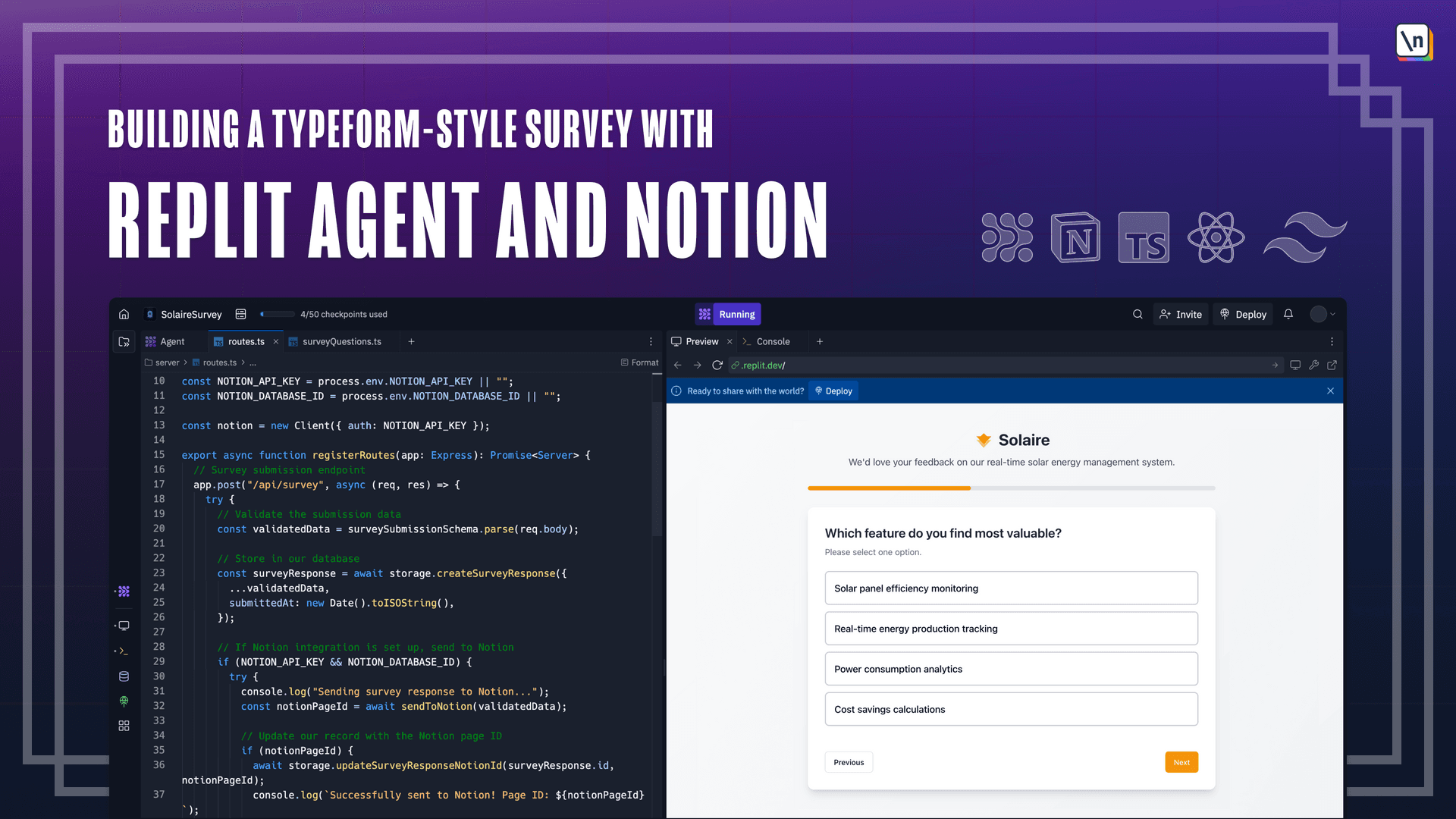Prompting Replit Agent
This lesson preview is part of the Building a Typeform-Style Survey with Replit Agent and Notion course and can be unlocked immediately with a \newline Pro subscription or a single-time purchase. Already have access to this course? Log in here.
Get unlimited access to Building a Typeform-Style Survey with Replit Agent and Notion, plus 90+ \newline books, guides and courses with the \newline Pro subscription.

[00:00 - 00:15] How do you prompt Repel agent? When we saw Repel agent provide those app suggestions and you saw those very concise descriptions, just giving it a single sentence prompt gives it a lot of leeway as to how to implement the application.
[00:16 - 00:38] And so what you want to do is that you want to be sure that you're giving it just enough details so that Repel agent isn't making too many decisions on its own, right? Because if you basically allow Repel agent to make a lot of decisions on its own, then what's going to happen is that the application might be guided in a direction that maybe you didn't necessarily intend.
[00:39 - 00:52] And so with that being said, I like to think of prompting Repel agent effectively in four steps. And obviously the first one is to start with a one sentence description of the application.
[00:53 - 01:15] So in this case, if we're going to be building a type form style survey that gathers user feedback and then sends it to a notion database, I guess that's probably the best way to start, right? So the initial prompt could initially begin with, OK, let's create a beautiful type form style survey that gathers feedback from users.
[01:16 - 01:34] And let's say, for instance, that for this hypothetical example, it's going to be gathering feedback from users for a real-time solar energy management system named Solaire. And we want to have the results be sent to a notion database.
[01:35 - 02:12] Now, if you do have trouble coming up with a concise one-sentence description, then you can obviously prompt Cloud AI or Gemini or even chat TPT to essentially help you come up with this one-line description so that it's nice and concise and it gives Repel Agent essentially a nice starting point for when it's initially coming out with the plan for building your application. Once you have come up with this one sentence, you will then want to add a detailed list of any features that the application should support.
[02:13 - 02:25] And obviously, the more items that describe how the survey should behave, the more likely that Repel Agent will generate exactly what you're looking for. So you just want to be very specific about the functionality about user interactions.
[02:26 - 02:36] So at this point, you just want to basically just establish a list of core features, right? So let's say, for instance, for this survey, we wanted to basically behave like typeform.
[02:37 - 02:50] So in a typeform-style survey, you want surveys to present questions one at a time. And generally, these questions are presented with smooth, polished, fade-in, fade-out animations between questions.
[02:51 - 03:15] And you want the survey to be able to support a variety of different question formats, whether that is multiple choice questions, rating scales, checkboxes for selecting multiple options, text input for open-ended feedback, anything of this nature. You would also want it to have form validation so that users are going to be providing responses for any question that's marked required.
[03:16 - 03:32] And you just want to make sure that the survey is going to be collecting answers that are properly formatted. So this way, when they're sent to a notion database, there will be no issues when responses might not be correctly formatted since it already have formatted them beforehand.
[03:33 - 03:48] And obviously, we want to make sure that these responses abide with notions API requirements. And then afterwards, we want to make sure that there's a progress bar at the top of the application so that it actually shows users their overall progress towards completing the survey.
[03:49 - 03:57] So whether or not they're on the first step or whether or not they're at the last step, we just want to make sure that users know where exactly they are in the survey. So this way, they're pretty close to finishing the survey.
[03:58 - 04:10] It'll give them that extra push to complete it. And then lastly, we want to make sure that when users submit their feedback, those responses are sent to a notion database and adds a new row to the notion database when the response is sent.